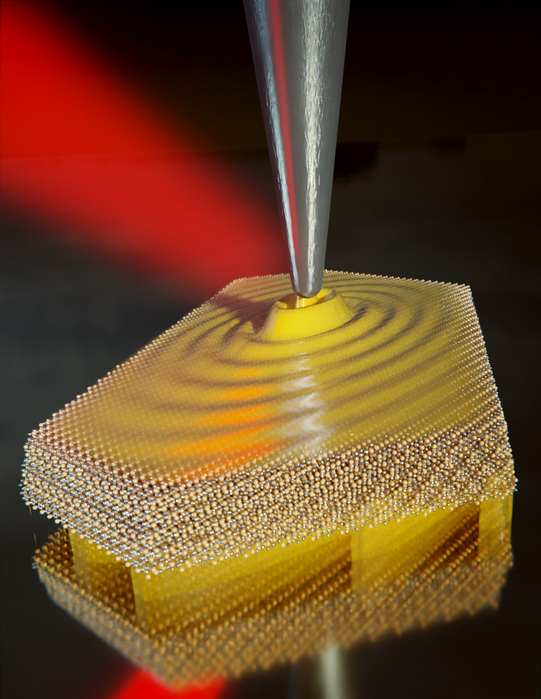An international research group has imaged and examined THz waves that propagate in the form of plasmon polaritons together with thin anisotropic semiconductor platelets with wavelengths decreased by up to 65 times more than THz waves in free space.

Artistic illustration of in-plane elliptical acoustic THz plasmon polaritons propagating along a thin Ag2Te platelet above an Au mirror, excited and probed by a sharp THz-illuminated metal tip. Image Credit: Scixel. Copyright: CIC nanoGUNE
This was done in collaboration with Basque research center CIC nanoGUNE, Shanghai University for Science and Technology, Fudan University (Shanghai), Brno University of Technology, University of the Basque Country, Materials Physics Center (CSIC-UPV/EHU), Donostia International Physics Center, and the Max Planck Institute for Chemical Physics of Solids (Dresden)
What is even more different is that the wavelengths change with the direction of propagation. Such THz waves could be employed for probing basic material properties at the nanometer scale, and it sets the stage for the development of ultra-compact on-chip THz devices.
The study has been reported in the Nature Materials journal.
Polaritons are known as hybrid states of light and matter, which emerge from the coupling of light with matter excitations. Phonon and plasmon polaritons come under the highly notable instances, developed by the coupling of light to collective electron oscillations and crystal lattice vibrations in a respective manner.
They play a vital role in several applications, ranging from sub-diffraction optical spectroscopy and ultrasensitive chemical sensors to ultra-compact modulators for communication applications.
In thin layers, polaritons have the potential to propagate with wavelengths ranging up to 100 times shorter compared to the corresponding photon wavelength. This enables the manipulation of light on a much smaller scale than what was earlier possible with traditional photonic devices.
While the majority of these ultra-confined polaritons have been noted in the form of phonon polaritons in the mid-infrared spectral range, the scientists emphasized plasmon polaritons, as these could exist in much more extensive spectral ranges.
On the other hand, plasmon polaritons often suffer from large damping, resulting in short propagation lengths. This has been challenging the observation of ultra-confined plasmon polaritons in real space.
Shu Chen, Study First Author, Terahertz Technology Innovation Research Institute, National Basic Science Center—Terahertz Science and Technology Frontier
Making use of a THz nanoscope (more accurately, a THz scattering-type scanning near-field optical microscope, s-SNOM) in Rainer Hillenbrand’s lab at CIC nanoGUNE (San Sebastian, Spain), Chen learned about thin platelets of the low-symmetry crystal silver telluride (Ag2Te; Hessite) and achieved the first real-space images of THz plasmon polaritons, whose wavelengths range up to 65 times reduced than the photon wavelength and change with the propagation direction.
“Silver telluride is a narrow bandgap semiconductor with a relatively high mobile electron concentration, which makes this material plasmonic at THz frequencies,” stated Pengliang Leng, equally contributing first author, who fabricated the platelets in Faxian Xiu´s lab at Fudan University (Shanghai, China).
Because of the low-symmetry monoclinic crystal structure, the effective electron mass is strongly anisotropic along the platelet surface, which explains the anisotropic plasmon polariton propagation.
Faxian Xiu, Physics Department, Fudan University
Also, the scientists illustrated that the comparative propagation lengths of the THz polaritons could be considerably increased by linking them with their mirror image in an adjacent metal substrate.
Because of this coupling, so-called acoustic plasmon polaritons are formed.
Andrea Konečná, Brno University (Czech Republic)
The acoustic polaritons were theoretically modeled by Konečná.
“Most important, the anisotropy of the polariton propagation is qualitatively preserved, and the long relative propagation lengths allowed us to unambiguously verify that the polaritons propagate with elliptical wavefronts”, added Rainer Hillenbrand from nanoGUNE, who headed the work.
The long comparative propagation lengths of the elliptical acoustic plasmon polaritons eventually enabled the scientists to identify the in-plane anisotropic effective electron mass, thereby establishing a special technique for the nanoscale measurement of directional effective carrier masses at room temperature.
Over exploring basic materials’ properties in traditional and novel quantum materials, ultra-confined in-plane anisotropic acoustic plasmon polaritons might result in ultra-compact on-chip THz applications.
The powerful field concentration present in the gap between the polaritonic layer and metal surface might be exploited for field-enhanced molecular sensing or boosting (ultra)strong THz light–matter coupling with classical 2D electron gases, molecules, or quantum materials.
Journal Reference:
Chen, S., et al. (2023) Real-space observation of ultraconfined in-plane anisotropic acoustic terahertz plasmon polaritons. Nature Materials. doi.org/10.1038/s41563-023-01547-8.